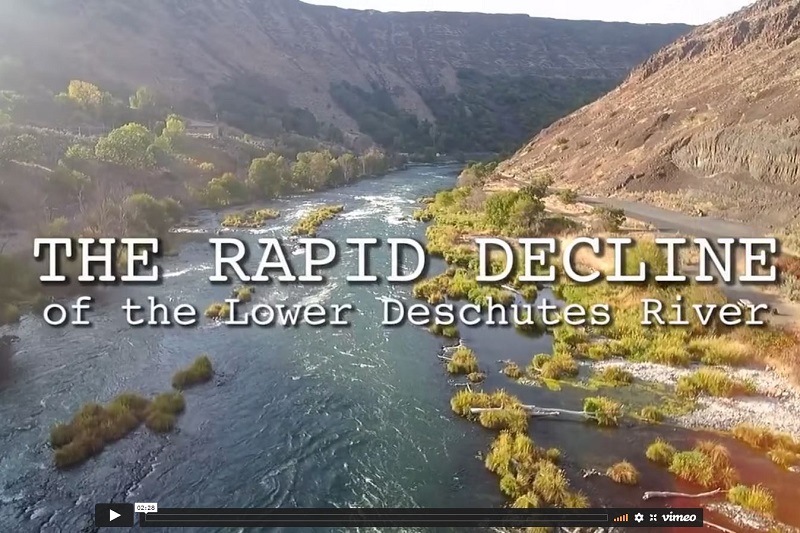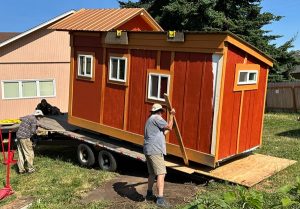Public asks EQC to help the Lower Deschutes
7 min read
The Deschutes River Alliance features a video about the rapid decline of the lower river.
The Environmental Quality Commission heard public comment on the Deschutes River. Commenters said the water temperature mixing tower at Round Butte Dam isn’t helping the river. They are now asking the state to enforce the law—before the fish are gone forever.
[00:00:14] Mia Sheppard: My name is Mia Sheppard, and my husband and I are outfitters. Visitors come from all over the country to recreate and fish for steelhead and salmon on the lower Deschutes. Currently there are about 36 fishing outfitters and a number of independent guides. Our businesses together generate millions of dollars each year to the state and local economy.
[00:00:35] But as the health of the lower river declines, fish lose and we lose. It’s not a coincidence that steelhead have been declining since the tower was put in place. And it’s not just ocean conditions. PG&E has struggled to meet standards and DEQ accommodates them so that they can release higher nutrients into the lower river. How many more years will you allow PG&E to not meet water quality standards? When there are no more steelhead or spring chinook? The last five years, the average number of wild sockeye counted at the dam is 22 fish. And that number is on their website.
[00:01:14] The mixing tower is not restoring runs to the upper basin. Last year, we lost our steelhead season and it could happen again. DEQ is not upholding the law and the (Environmental Quality) Commission is allowing it. Do you want this to be your legacy—to see steelhead and salmon go extinct, and the Deschutes ruined? The mixing tower is not working and it’s time to end the experiment.
[00:01:37] Forrest Foxworthy: My name is Forrest Foxworthy. I am a long-time Oregon fishing guide. I’ve been working on the lower Deschutes since 1984 so I’ve been there for quite a while.
[00:01:48] Regarding the Deschutes, I believe somewhere close to 22 different state and federal agencies signed off on this project. They should all be ashamed of themselves for the way they have treated the lower river and looking the other way to concerns that we have been bringing to the table now for quite a while.
[00:02:04] No one told river users water withdrawal practices were going to alter aquatic bug life and create algae. No one told river users the river would exceed 70 degrees numerous times in early summer, which was rare prior to the project. No one told us we would have to implement 2 p.m. closures on our steelhead fisheries due to the water being so warm. No one told us water changes would allow bass and walleye to invade the river…
[00:02:29] DEQ should represent all people of the state and the Deschutes River, not just one large corporation.
[00:02:36] Amy Hazel: My name is Amy Hazel. I’ve been a guide on the Deschutes for 22 years, so about half of my time on the Deschutes was pre-tower and half of my time was post-tower, and I can tell you the differences in the fish and the fishing and the biology of the river are astounding. I used to take people out and fish dry flies. That is the reason people go fly fishing to have a dry fly on the surface and watch a fish come up and eat it.
[00:03:05] We don’t have that anymore on the Deschutes for the most part, because all of the rocks that are close to the edges of the river, where the fish used to live and eat insects are smothered with algae. And those insects are no longer hatching in the abundance that they once did. And that is directly related to the tower.
[00:03:24] I have been keeping journals on my fishing on all of my guided trips for 22 years. Water temperatures are insanely higher than they ever were before. I’ve found journals in ‘99 where I’ve got concerns because the river gets up to 65 degrees. Now it’s regularly up to 70 and that five degrees is lethal to steelhead, to salmon. And it’s horrible for the fishery. It’s horrible for the trout. We’re basically seeing the extinction of spring chinook on the Deschutes and these are all problems related directly to the tower.
[00:04:01] I just want DEQ to enforce the 401 cert(ification)s that they agreed to enforce. We need enforcement. That’s all we’re asking for. PGE agreed to these water quality standards. And all they’ve done is meet behind closed doors with DEQ to get water quality standards lowered because they can’t meet the regular water quality standards.
[00:04:27] Mitch Willis: My name is Mitch Willis. I began fishing on and floating on the Deschutes River in 1973, 48 years ago… When that selective water withdrawal tower was implemented, the river became filled with algae.
[00:04:47] There are now elodea thickets on the shoreline. The temperature and pH is out of this world, and I caught a bass nine miles up the river—making what used to be a cold water fishery, a warm water fishery. I would beg the DEQ to please enforce the laws that are in place.
[00:05:13] Greg Fitz: My name is Greg Fitz. I’m commenting today on behalf of the membership of the Wild Steelhead Coalition… To put it bluntly, we’re devastated by the state of crashing summer steelhead populations in the Deschutes basin and the water quality changes to the lower river. We’re deeply concerned about the health of the entire basin fish populations, especially spring chinook, sockeye salmon, native redside and bull trout.
[00:05:38] I really just want to amplify and reiterate the need for DEQ to more consistently enforce the existing state regulations and agreed upon standards governing water quality in the Deschutes, especially the lower Deschutes, around pH level, excessive nutrient loads, water temperature, and dissolved oxygen levels. It should go without saying that these standards are fundamental for river ecology and fishery health… This incredible river deserves nothing less.
[00:06:09] Bill Bakke: Bill Bakke. I wanted to draw your attention to a water temperature in the Deschutes River and one of the major problems that kind of goes unnoticed is the effect of the plume in the Columbia River. That was designated as a thermal refuge, and it’s the last one on the Columbia River before you get to the Snake River. That plume is extremely important, yet the Deschutes River is flowing and it’s 70 degrees or more during the summer, and it negates the value of that plume. In 2015, we lost 250,000 sockeye salmon coming up the Columbia River because of hot, low water…
[00:06:46] We have three viable steelhead populations in the tributary creeks, but we have a growing bass population in the stream, and they’re also eating juvenile fry and smolts of the steelhead. It’s important to take into consideration the flow, the temperature, and the impact of algae on the bottom of that, suffocating aquatic insects, because the Deschutes River will not actually be able to be restored, aside from ocean conditions in the Deschutes River itself, unless these conditions are corrected.
[00:07:21] Steven Pribyl: My name is Steven Pribyl. I retired from ODFW (Oregon Department of Fish and Wildlife) after a 30-year career as a fish biologist; 23 of those years were spent working on the Deschutes River, starting in 1977.
[00:07:33] Wild spring chinook in the Deschutes River have been driven to the very brink of extinction. This is caused by the large increase in nutrient inputs and increased water temperature from selective water withdrawal tower operation, causing a huge increase in the intermediate host of a fish disease organism called Ceratonova shasta. Research by OSU and ODFW has confirmed nearly 100% mortality in juvenile spring chinook exposed to the Deschutes water because of C. shasta infection.
[00:08:08] Similarly, the mortality of wild adult spring chinook swimming up the Deschutes has gotten so severe that the entire wild run has been taken out of the wild and placed into captivity some years in hopes of saving that population and maintaining their genetic material. Fish reintroduction has been a massive failure for 12 years. Water quality and the Deschutes and the reservoirs has been measurably harmed as evidenced by the ongoing violations in water quality standards.
[00:08:39] Sarah Cloud: I’m Sarah Cloud, Executive Director of the Deschutes River Alliance…
[00:08:43] The lower Deschutes River is a special place. It’s an internationally known destination for angling, rafting and all kinds of outdoor pursuits. We believe firmly that we have a right to enjoy this valuable resource, not only for our generation, but for generations to come. We also believe very firmly that we have a duty to protect it.
[00:09:02] The state agency charged with the task of protecting this river is looking the other way as the river is being harmed. They are not enforcing the contract that was written via a very public process and agreed to by the operators. Instead they are allowing backroom deals to dictate how the river is being managed. This needs to change. The wild and scenic lower Deschutes River and the communities that rely on it deserve better.
[00:09:28] The Deschutes River Alliance has a simple request. We want the EQC to ensure that the DEQ enforces all of the water quality standards that apply in the lower Deschutes River. We just want water quality laws of the state of Oregon and the provisions of the 401 cert(ification) to be enforced.
[00:09:47] John Q: Public comment on April 6th begging the state to do its job and protect the Deschutes.



